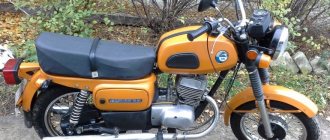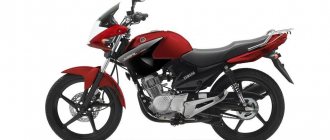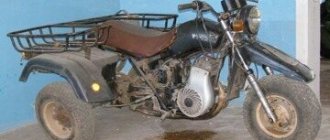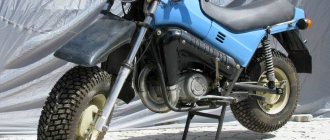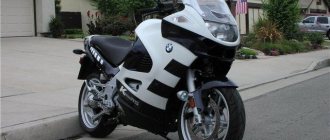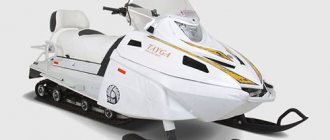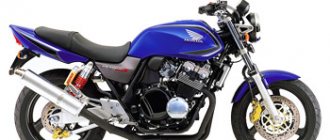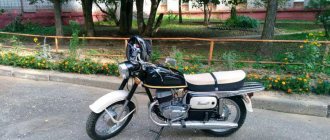It is no coincidence that the Soviet road motorcycle Voskhod-ZM is still remembered and appreciated by domestic motorcyclists. Soviet teenagers witnessed his high popularity. The light weight of the motorcycle allows it to withstand a load of 160 kg. Despite its decent quality and reliable safety system, it was discontinued in 1993.
Specifications
The motorcycle is suitable for traveling on the highway and along rural roadways. It has the following technical characteristics:
- parameters of length, width, height – 2x0.85x1.2 m;
- ground clearance - 12.5 cm;
- weight – 122 kg;
- single-cylinder two-stroke engine with a volume of 173 cc. cm;
- engine with a power of 15 hp. With.;
- maximum possible speed – 105 km/h;
- fuel consumption – 4.2 l/100 km;
- fuel tank volume – 14 l;
- 4-speed gearbox;
- the presence of a drum brake makes the overall weight smaller and simplifies the maintenance process;
- at a speed of 60 km/h, the braking distance is 20 m;
- the presence of an anti-theft system in the form of a steering lock;
- it is possible to change the position at the steering wheel, which will add convenience to drivers of any height;
- the power supply operates from 12 volts and has a 65-watt generator;
- the front telescopic fork and rear pendulum system are used as suspension;
- The model is equipped with 16-inch alloy wheels.
Versions and photos of the Soviet motorcycle "Voskhod"
The first motorcycle "Voskhod" began in 1965. In comparison with its predecessor (K-175V), the single-cylinder two-stroke engine of the motorcycle has added power.
Motorcycle Sunrise 2
The road "Voskhod 2" replaced the initial model of this series, it was even more powerful than its "father", but this is where the main transformations ended, if you do not take into account its appearance. Updated headlights appeared, and the direction indicators became round. There were also improvements in the electronic ignition system and updated alarm devices were added. Compared to the previous model, these innovations are quite minor, but, nevertheless, they were a pleasant addition.
The new Voskhod 2 became a little faster and could reach its speed up to 95 km/h, but at the same time it “gained weight” by several kilograms.
In 1977, the improved Voskhod 2M came to replace it. The engine remains the same in volume, but has now become even more powerful. This modernization was achieved by increasing the configuration of the channels in the crankcase and cylinder. The changes also affected some details: the motorcycle suspension and shock absorbers were improved. The new bike became heavier, now weighing 121 kg and faster by as much as 10 km/h.
Following its predecessor, Voskhod 3 was released. The model, of course, has become significantly better than its predecessors. An updated intake system and brake system were installed. The driver's seat has now become more comfortable. But the maximum speed has not changed, despite the fact that the weight has increased, now it is 125 kg.
In 1984, Voskhod 3M was born. It was implemented properly and is quite reliable. The motorcycle continued its production until the end of 1992. Low and high beam indicators and a speedometer began to appear on the panel. The driver's footrests were installed and reclined. The maximum speed has not been changed, and the weight has become several kilograms less than that of Voskhod 3.
In 1985, Voskhod 3M-tourist was created. This version was equipped with strong safety arches, a completely updated steering wheel and travel equipment. But the weight, as well as the speed, were not changed.
Motorcycle tuning Voskhod
And the last reincarnation - Voskhod 3M-01, was created in 1989. Only the motorcycle engine with a reed valve was subject to significant modifications. With its help, it was possible to reduce fuel consumption to 4.2 liters per 100 km. The steering wheel has become somewhat wider, and thus more comfortable. And on this model, the Voskhod motorcycles completed their transformation, and the Sova brand continued production.
Nowadays, the production of motorcycles at the plant named after. Degtyarev is still in force, but there is now nothing in common between the Voskhod line and the plant. The latest modifications turned out to be completely unprepared for the current conditions of market competition.
Although the Voskhod motorcycle represents a classic of the last century, it is still popular in our time, and is famous for its unpretentiousness and cheap repairs. But new Ural motorcycles can compete with it.
Appearance
The design of the motorcycle cannot be called attractive, since during its creation the emphasis was placed more on the internal content. The shape of the fuel tank, slightly pushed forward, can be called rectangular. The fuel tank is located next to the driver's seat. Its upright position allows the driver to remain upright and makes movement comfortable.
The possibility of direct landing is an indicator of classic style. The classic design also implies other design features, for example, the presence of a low steering wheel. You can hold onto it with straight arms without bending your elbows. This not only allows you to better control the movement, but relieves your hands from numbness. Thanks to the comfortable position of the footrests, the legs are bent straight, which makes the ride more comfortable.
Chrome was used to cover the exhaust pipes; they are in a horizontal position. The appearance of painted mudguards adds to the attractiveness of the model.
Advantages and disadvantages
Motorcyclists note the excellent build quality of the motorcycle, which guarantees its durability. In addition, the following advantages of the Voskhod-3M motorcycle can be highlighted:
- speed and power have decent performance;
- ease of control and instant response to driver actions;
- unpretentiousness in maintenance;
- low price.
Among the disadvantages are the following:
- a lot of noise and vibrations when moving make motorcycle trips not very comfortable;
- rapid overheating due to the lack of cooling systems;
- will not work if there is no oil in gasoline;
- unattractive design.
Watch a video review of the Voskhod-3M motorcycle:
Moto-Kovrov
"SUNRISE"
Carrying out the party's directives to introduce the achievements of scientific and technological progress, Kovrov motorcycle builders began to create a more modern machine. The designers sought to bring the model under development closer to the best foreign models. And they achieved it.
On October 12, 1964, the Voskhod spacecraft was launched - the world's first multi-seat vehicle - with a crew consisting of cosmonaut-pilot Komarov, designer Feoktistov and doctor Egorov. The propaganda effect of the new achievement of Soviet science and technology was colossal. And employees of the SKB motorcycle manufacturing plant named after V.A. Kovrov. Degtyarev, who were just then developing a new motorcycle model, did not puzzle over what to call it. Of course, "Sunrise"!
The Voskhod motorcycle model was designed in 1964, and began its journey to the consumer with the release of a pilot batch of 298 pieces at the end of 1965. Factory designer Leonid Avgustovich Zveryuga managed to create a memorable, integral look - without resorting to copying foreign designs. Before this, “Voskhod-1” (as the motorcycle was listed in the technical documentation) was tested in competitions with foreign motorcycles.
The 1965 motor rally was held in Germany in Nuremberg on the Nurburgring track, where the riders arrived without breakdowns or delays. Here the factory motorcyclists achieved success, winning the FIM prize - “Horse in the Race”.
Then a performance in 1966 in France.
Later, performing at the 1968 motor rally in Italy, the Kovrov team took an honorable second place and received the Monaco Cup prize.
According to the competition conditions, the team covered the path from Kovrov to Perugia on motorcycles.
A motorbike rally was also organized to places of military glory along the route Kovrov - Moscow - Minsk - Brest - Kyiv - Kovrov.
The motorcycle under the new trademark “Voskhod” was based on events such as; improving the appearance, increasing the performance of the motorcycle, increasing reliability and durability, eliminating defects that occurred on the previous model.
The team of workers and engineers was awarded a gold medal by the VDNH exhibition committee for their creative work.
Engine
The engine retained the basic design - single-cylinder, two-stroke, short-stroke (61.75x58.0 mm = 173.7 cm³), but thanks to an increase in the compression ratio, a change in the outlet angles of the purge channels and a decrease in the intake tract resistance, the maximum power increased from 9.5 to 10 liters .With. at 5300 rpm. At the same time, the maximum speed of the motorcycle increased from 85 to 90 km/h, and fuel consumption decreased by 0.1 liters per 100 km. The engine of the Voskhod motorcycle was equipped with a modernized gear shift mechanism, which made it possible to reliably record the engagement of the corresponding gear. For the gearbox, special mounting dimensions for the gears were calculated using a compensation washer installed at the left input shaft bearing, instead of the one installed on the previous model at the main gear. The rubber covers for the reverse gear had special flaps that closed two technological holes in the right half of the crankcase, the third technological hole was closed with a rubber plug. These measures prevented the access of dust, dirt and water to the reverse gear chain and thereby increased its service life. The new design of the breather became sealed - in it the crankcase cavity was connected through a PVC tube to the receiver of the suction noise muffler. This design prevented dust, water and dirt from entering the crankcase.
The air purification system has been changed. The receiver, which simultaneously serves as an intake noise silencer, was connected by two rubber pipes to the air filter housing, and not one as was the case on the previous model. The filter element, instead of a metal mesh, was made of elastic polyurethane foam, resulting in improved air purification. The air filter consisted of a housing and a cover, which were made of nylon, as well as a metal grille and a filter element impregnated with motor oil mixed with gasoline.
The carburetor cover was shaped differently from the previous model.
Electrical equipment
On the motorcycle, instead of the G-401 generator, a new G-411 generator was installed, the power of which was 10 watts higher. The G-411 generator had a new capacitor with a capacity of 0.25 microfarads. This generator ensured uninterrupted sparking in the range of 350-6000 rpm, significantly improved road illumination and increased the lighting characteristics of signal devices. There was a special output from the generator stator for the brake light.
A special B-300 ignition coil was designed for the new generator.
Instead of the FG-38V1 headlight, a new FG-138 headlight was installed.
The headlight rim received a visor, a new diffuser design and a headlight lamp with filaments of the same power were also used. These changes reduced the possibility of burnout of headlights and taillights and ensured good asymmetric illumination of the road.
The FP-66 rear light of the previous design was obsolete and did not meet the aesthetic requirements of that time. Therefore, a new design taillight with a plastic housing was installed on the Voskhod. It had two lamps, one of which worked as a signal and illuminated the license plate, and the second was intended for the brake light. In the right tool box, two M5 screws were used to secure the brake light switch, driven by a spring from the foot brake pedal.
The rear light wire had a plug connector, instead of being connected with a screw and nut through terminals.
To improve appearance, the switch base, lever and signal button were made of cream-colored plastic, and the metal body was painted with ivory enamel.
Crew part
On the previous model, the side closures had a rubber wrapping cord secured with nine galvanized rings; later, a wide ivory-colored polyvinyl chloride cord was used.
The modified design of the closures allowed the use of a new profile of ivory-colored PVC wrapping cord. The appearance of the motorcycle has improved significantly.
The newly designed folding seat provided easy access to the air filter and pump, mounted in brackets on the seat frame.
The new seat cushion has increased its elastic properties and improved ride comfort for both driver and passenger.
The shape of the new two-tone seat cover (red top, black bottom) has significantly improved the appearance of the motorcycle in terms of aesthetics. A new ivory colored PVC passenger handle was attached to the seat using two M6 screws. The designers also strengthened the frame structure, increasing the diameter of the front and top tubes from 32 to 34 mm.
The main changes in the design of the front fork were that a nylon reflector was installed in the springs, which prevented oil from leaking out when the fork was activated through the breather holes in the plugs.
The new Voskhod fuel tank received nigrips (knee pads) of a new shape, an ivory-colored polyvinyl chloride edging covering the weld seam, a new logo in the form of a horizontal arrow made of white plastic and the inscription “Voskhod” made of brown plastic.
All these measures significantly improved the appearance and fully met the aesthetic requirements of that time. The fuel tank plug was made of ivory-colored plastic.
Using two racks fixed in the area of the headlight and the upper yoke, and four special brackets, a windshield made of organic glass was installed on the motorcycle.
Taking into account numerous requests from consumers, a small trunk with an estimated load of 15-18 kg was installed on the new model.
The steering wheel brackets had a different appearance.
The control knobs were installed with a new design and were made of elastic light rubber that did not stain your hands.
The “lamb” type damper head and the enrichment shifter were made of a more durable MCH material, ivory-colored.
To prevent dirt from getting on the driver's clothes, the motorcycle was equipped with knee guards made of black or white nylon.
The front wheel hub cap has been redesigned for easier polishing.
The design of the base of the front wheel brake pads was changed, for the convenience of processing the outer surface of the base; the support bracket for the front brake cable sheath was removable and secured with an M6 bolt.
The short brackets for fastening the rear shield on the yoke handle were replaced with elongated chrome ones, which, in addition to improving the appearance, significantly reduced the vibration of the rear shield and thereby eliminated the possibility of transverse cracks. The yoke handle on the new model was missing.
The round driver and passenger footpegs have been changed to more modern square ones.
Instead of painting, the wheel hubs, front and rear brake bases were polished and glossed.
Instead of galvanizing, the following were coated with chrome: front and rear brake levers, foot brake pedal, chain tensioners, brackets and control levers for the clutch, decompressor and front brake, front fork oil seal housings, throttle handle housing, throttle handle mushroom, as well as a number of fastening parts: bolts, screws, nuts and washers.
For the first time on the Voskhod motorcycle, a rear view mirror was installed on the left handlebar.
The bushings of the front fork casing, made of TsAM alloy, were replaced with nylon ones, which eliminated the unpleasant “rattling” of the casings.
All specific parts and assemblies: fuel tank, front and rear wheel guards, closures (side and top), tool box covers, front fork casing, upper and lower traverses - before coating were thoroughly cleaned to a glossy surface according to standards, then phosphated, primed and painted with synthetic enamels, followed by polishing and glossing to a mirror surface. The headlight was supplied by a related company in black. Motorcycles were painted black and blue.
In 1967, to celebrate the 50th anniversary of the Great October Revolution, a limited batch of motorcycles was assembled.
On the front fender of these motorcycles there was an aluminum flag with the image of a “hammer and sickle” and the inscription “50 years” on a red background.
This batch of motorcycles was painted red. Knee pads were installed in cream-colored metal.
The number of motorcycles assembled is unknown.
In 1969, another limited edition (anniversary) was released to celebrate the 100th anniversary of the birth of V.I. Lenin.
On the front fender of these motorcycles there was an aluminum flag with the inscription “1870-1970 Jubilee” on a red background.
The anniversary party was also painted red. Metal knee pads were painted ivory.
The number of motorcycles assembled is unknown.
Both batches of motorcycles were produced of excellent quality in export versions.
From 1965 to 1972 1,039,484 Voskhod motorcycles were assembled.
Motorcycles collected for the 50th anniversary of the October Revolution and the 100th anniversary of Lenin can be viewed in the private museum of Nikolai Tubaev.
Price
The cost of the Voskhod-ZM motorcycle on the secondary market is low - on average 25-30 thousand rubles (depending on the condition it can range from 15 to 50 thousand rubles), which makes the purchase quite affordable.
The cost level is determined based on various indicators:
- general condition;
- technical characteristics;
- Year of release;
- availability of repairs;
- appearance.
The low mileage of the motorcycle guarantees its high demand.
Tuning options
Refinement of the design involves internal or external tuning. During internal modifications, the engine is rebuilt, driving parameters, suspension, and brakes are optimized. When external modifications are made, the motor vehicle is given a sporty style or it is converted into a chopper.
Features of internal tuning
Owners often rework the Voskhod-3M engine. To increase engine thrust, the factory paper air filter is replaced with foam filter elements. This helps reduce air exhaust friction. Then the jets and diffusers are polished using an abrasive material, the diameter of which affects the volume of fuel entering the engine.
To improve the fuel exhaust system, a new modernized carburetor is installed. From the existing pipe, take flanges for mounting on the cylinders, grind out aluminum bushings, and cut off the flange from the exhaust pipe. In an old carburetor, take a second flange. Using cold welding, the parts are connected.
The design is adjusted until it fits perfectly into the exhaust channels. Internal gaps are filled using epoxy glue.
Often rear adjustable shock absorbers are installed and sports tires are installed. When performing such tuning, the motorcycle becomes more aggressive and sporty.
Performing external tuning
In a sporty style
With a low seating position and a high front fork, there is a desire to modify the motorcycle in accordance with the sporty style. To do this, raise the rear shock absorbers and replace the exhaust pipe elbow. This way the exhaust pipe is level with the rear axle. Exhaust pipes with a larger diameter will improve the design and increase the traction of the bike.
External modifications can include painting, chrome plating, installation of nickel-plated arches instead of the old factory protection, installation of large rear-view mirrors, stepped seats and wheel tuning.
At the end of the tuning, a sports fairing is installed.
Chopper
When performing tuning for a chopper, shortened rear shock absorbers are cut off or purchased. Thanks to this replacement, the rear of the motorcycle will be lowered by several centimeters. The rear fork and wheel are replaced with wider ones. The angle of inclination of the front fork axis is replaced, and the cylinder covers are equipped with chrome plated cups. The same style is followed when tuning the headlights, rear lights, and dashboard.
Tuning for Cafe-bike
With such a modification, to reduce costs, they weld the rear part of the frame with their own hands, shorten the fork, trim and adjust other parts. For the steering wheel and seat, your own strength may also be sufficient. A headlight with a brake light is installed from trucks.
Most owners can carry out tuning on their own using only purchased parts due to the simplicity of the designs and the low cost of spare parts.
Intermediate stage between Voskhod-3M and the new ZDK family
Motorcycle Voskhod-3M-01
I think it’s no secret that putting a completely new model on the production line is quite a complicated matter. As a rule, it is necessary to purchase and install new equipment and reconstruct old production. It’s labor-intensive, expensive, and you also have to follow the plan. That is why most motorcycle and automobile factories are switching to new equipment gradually, step by step, introducing new components into serial production. This is how transitional models appear.
The presented “Voskhod-3M-01” is just such an intermediate step between the well-known “Voskhod-3M” and the new family of ZDK (we will introduce you to it later).
Owners of motorcycles from the Kovrov plant will be interested to learn about the design features of this motorcycle and the level of unification with previous models.
The main difference is the new engine. With the same working volume (175 cm3), its power increased to 10.7 kW, while the appetite was somewhat moderated. The crankcase, cylinder and its head have become different. The changes to the crankcase, however, did not affect the mounting points of the engine to the frame, so it can be installed on previous models - Voskhod-2, 2M, 3, 3M. True, this will require new exhaust noise mufflers (there is now only one) with an exhaust pipe and nuts and intake noise. If you install this engine on a model with 6-volt electrical equipment (2, 2M, 3), you will have to replace the 43.3701 or 80.3701 generator with the G-427. The generator seats are unified.
The area of the cooling fins on the new cylinder has been increased; they are located horizontally on the head. This reduced the thermal stress of the cylinder-piston group parts and reduced the noise level. Increasing the height of the cylinder made it possible to lengthen the purge channels. Now, moreover, there are five of them, and the blowing has improved.
To reduce fuel consumption and reduce the crankshaft speed corresponding to the maximum torque, a check plate valve is installed in the intake duct.
In the piston, the hole for the finger is shifted 7 mm upward, closer to the bottom, that is, to the center of gravity, which reduced knocking when “shifting” the piston at dead spots,
The remaining mechanisms: starting, gear shifting, clutch, and gearbox were taken entirely from the Voskhod-3M motorcycle engine.
The original part of the new engine is the crankshaft. Now its flywheels are made integral with the axles, this eliminates the possibility of the former turning relative to the latter (this sometimes happened before). All geometric dimensions remain unchanged, and it can be used on previous models.
Reducing the exhaust noise level is achieved through a new acoustic system, made, as usual, in the form of chambers and a resonant tube, which increase the path of exhaust gases and reduce their speed. To reduce the noise (by 1.5 dB) emitted by the muffler body, a double wall is installed in its front power part.
As for the parts of the chassis and carriage, the changes affected the front fender, the saddle, and some additional equipment appeared.
The plug is similar in its technical parameters and connecting dimensions to the old one. Only the traverse design became different. On the top there are two conical holes in which elastic bushings are located for suspension of the steering wheel. Such a crossbar, together with fastening elements, can be installed on the front fork of motorcycles starting from Voskhod-2M. To prevent the steering wheel from turning in the clamps, it is knurled, and a jumper is introduced to increase rigidity.
The Voskhod-3M-01 motorcycle will be produced with two versions of front guards: a serial steel one with movable pipes and a new plastic one. For the latter, another lower traverse is used, in which there are 4 holes for its fastening. This, in turn, required a fork stop welded to the front frame brace. The new stop allows you to install any version of the traverse (including those from previously released models). The use of a new crossbar together with a plastic front shield on the Voskhod-3, 3M motorcycles would require alteration of the fork stop. This is not recommended, since in this case damage to the front strut, the most loaded element of the frame, may occur.
To give the motorcycle a more modern appearance, the shape of the rear part of the saddle has been slightly changed.
The fairing, roll bars, and rear trunk can be installed on other models. The trunk will be available in two versions: with and without side shelves.
The motorcycle is equipped with a side stand. Those interested can buy the central stand of the Voskhod-ZM model and equip it with it on a new motorcycle themselves; the bracket on the frame is retained.
D. YUDIN, engineer
